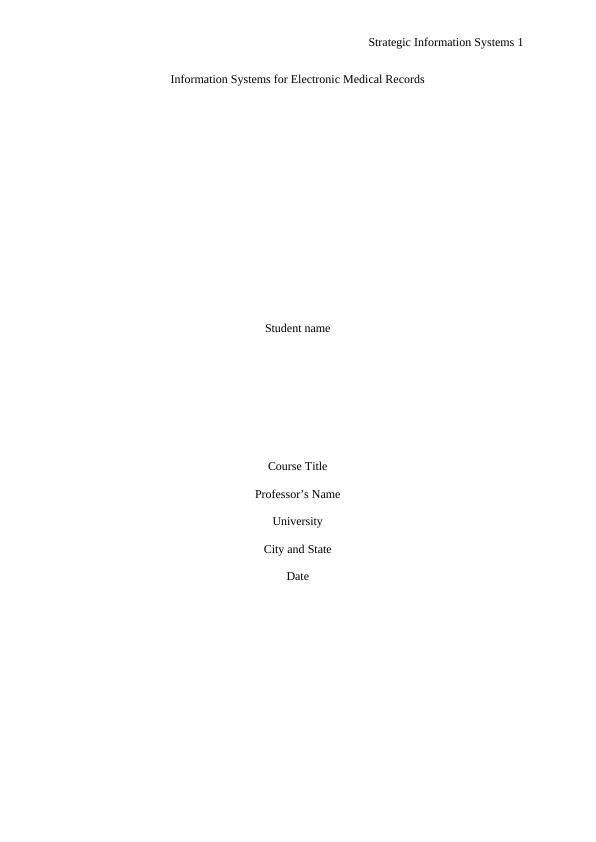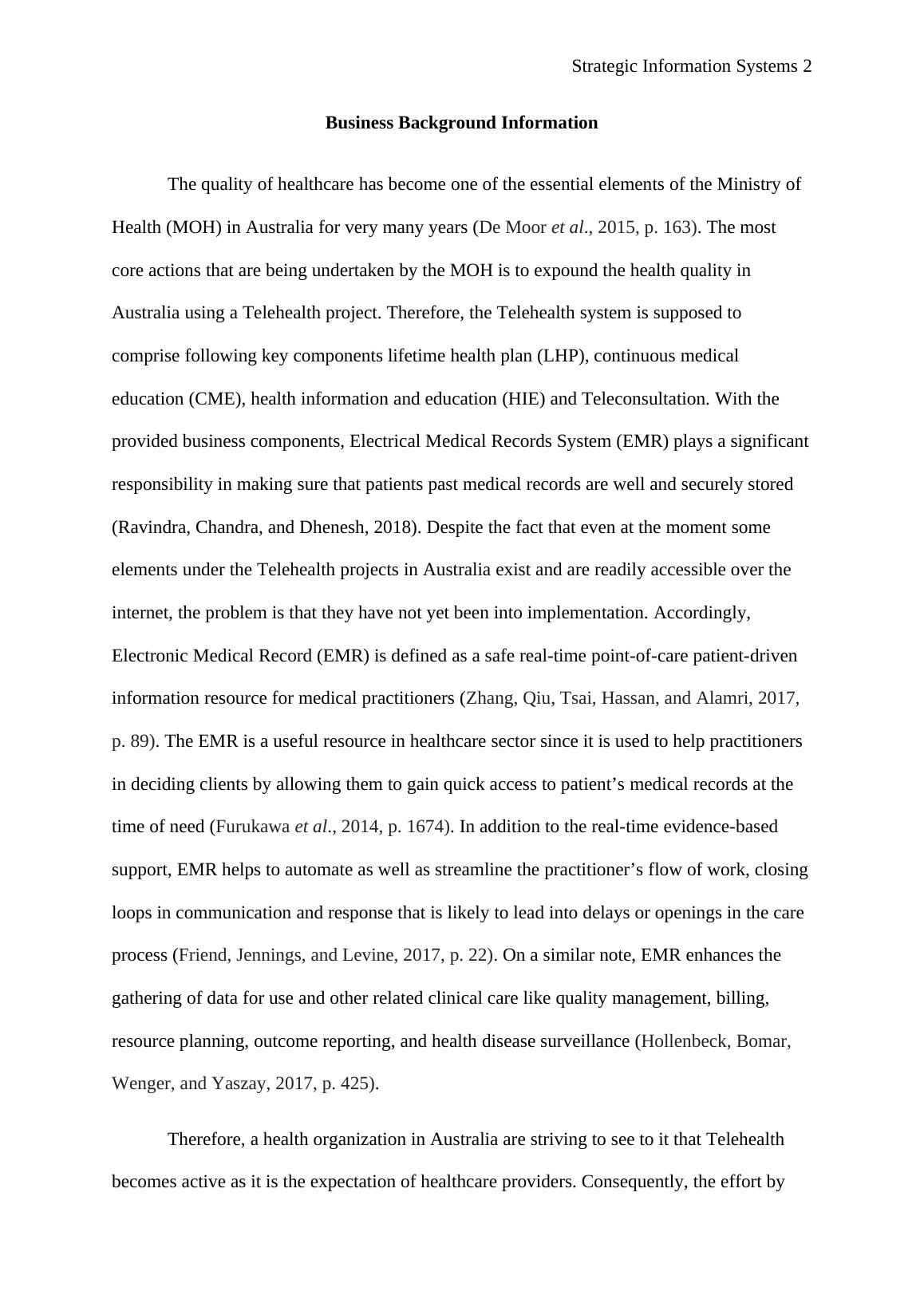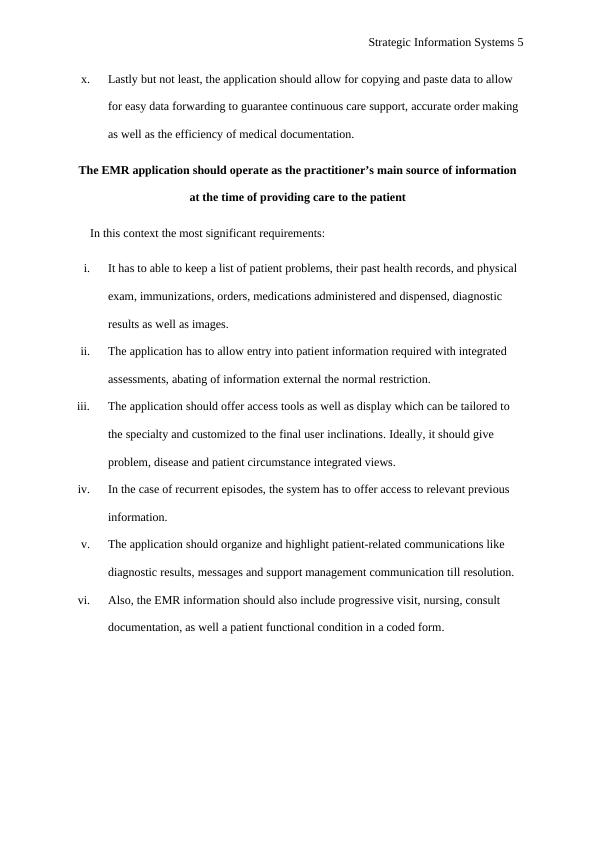Strategic Information Systems- Doc
21 Pages5374 Words23 Views
Added on 2021-06-16
Strategic Information Systems- Doc
Added on 2021-06-16
ShareRelated Documents
Strategic Information Systems 1
Information Systems for Electronic Medical Records
Student name
Course Title
Professor’s Name
University
City and State
Date
Information Systems for Electronic Medical Records
Student name
Course Title
Professor’s Name
University
City and State
Date

Strategic Information Systems 2
Business Background Information
The quality of healthcare has become one of the essential elements of the Ministry of
Health (MOH) in Australia for very many years (De Moor et al., 2015, p. 163). The most
core actions that are being undertaken by the MOH is to expound the health quality in
Australia using a Telehealth project. Therefore, the Telehealth system is supposed to
comprise following key components lifetime health plan (LHP), continuous medical
education (CME), health information and education (HIE) and Teleconsultation. With the
provided business components, Electrical Medical Records System (EMR) plays a significant
responsibility in making sure that patients past medical records are well and securely stored
(Ravindra, Chandra, and Dhenesh, 2018). Despite the fact that even at the moment some
elements under the Telehealth projects in Australia exist and are readily accessible over the
internet, the problem is that they have not yet been into implementation. Accordingly,
Electronic Medical Record (EMR) is defined as a safe real-time point-of-care patient-driven
information resource for medical practitioners (Zhang, Qiu, Tsai, Hassan, and Alamri, 2017,
p. 89). The EMR is a useful resource in healthcare sector since it is used to help practitioners
in deciding clients by allowing them to gain quick access to patient’s medical records at the
time of need (Furukawa et al., 2014, p. 1674). In addition to the real-time evidence-based
support, EMR helps to automate as well as streamline the practitioner’s flow of work, closing
loops in communication and response that is likely to lead into delays or openings in the care
process (Friend, Jennings, and Levine, 2017, p. 22). On a similar note, EMR enhances the
gathering of data for use and other related clinical care like quality management, billing,
resource planning, outcome reporting, and health disease surveillance (Hollenbeck, Bomar,
Wenger, and Yaszay, 2017, p. 425).
Therefore, a health organization in Australia are striving to see to it that Telehealth
becomes active as it is the expectation of healthcare providers. Consequently, the effort by
Business Background Information
The quality of healthcare has become one of the essential elements of the Ministry of
Health (MOH) in Australia for very many years (De Moor et al., 2015, p. 163). The most
core actions that are being undertaken by the MOH is to expound the health quality in
Australia using a Telehealth project. Therefore, the Telehealth system is supposed to
comprise following key components lifetime health plan (LHP), continuous medical
education (CME), health information and education (HIE) and Teleconsultation. With the
provided business components, Electrical Medical Records System (EMR) plays a significant
responsibility in making sure that patients past medical records are well and securely stored
(Ravindra, Chandra, and Dhenesh, 2018). Despite the fact that even at the moment some
elements under the Telehealth projects in Australia exist and are readily accessible over the
internet, the problem is that they have not yet been into implementation. Accordingly,
Electronic Medical Record (EMR) is defined as a safe real-time point-of-care patient-driven
information resource for medical practitioners (Zhang, Qiu, Tsai, Hassan, and Alamri, 2017,
p. 89). The EMR is a useful resource in healthcare sector since it is used to help practitioners
in deciding clients by allowing them to gain quick access to patient’s medical records at the
time of need (Furukawa et al., 2014, p. 1674). In addition to the real-time evidence-based
support, EMR helps to automate as well as streamline the practitioner’s flow of work, closing
loops in communication and response that is likely to lead into delays or openings in the care
process (Friend, Jennings, and Levine, 2017, p. 22). On a similar note, EMR enhances the
gathering of data for use and other related clinical care like quality management, billing,
resource planning, outcome reporting, and health disease surveillance (Hollenbeck, Bomar,
Wenger, and Yaszay, 2017, p. 425).
Therefore, a health organization in Australia are striving to see to it that Telehealth
becomes active as it is the expectation of healthcare providers. Consequently, the effort by

Strategic Information Systems 3
health organizations pushing for the use of information technology (IT) in the health sector is
to ensure that it achieves the perspective of patients gaining access to care at any place
instead of being forced to travel to their registered care (West, Borland, and Hammond,
2014). As a result of using Electronic Medical Records in the admission of healthcare
services in Australian hospitals, it would greatly help to reduce the hassle and tussle that id
faced by most patients in Australia who have before suffered challenges regarding receiving
medical services from healthcare facilities they are not registered.
Essential Business Requirements
The demands of the healthcare sector in Australia is recommending the use of EMR
implementation in all local, regional and national healthcare organizations because of various
reason. The most key requirement being to make sure that as a country it stands a better
position to ensure that the health of its citizens comes first.
Offer secure, dependable and real-time access to patient health record information
when and when it is required for the support of care
Therefore, some of the highly important requirement here include to provide tools and
equipment such as audit trails, to guarantee patient clinical information confidentiality as
safety (Ginsberg, 2017). The systems should be accessible and reliable such that it should be
capable of running 24 hours in a day, seven days, in a month and all year round. Similarly,
the system should be highly responsive and able to integrate with the healthcare flow of
work. On the same note, it should be readily accessible whereby it has to support ambulatory
care sections and inpatient as well as remote access.
The systems should be able to capture longitudinal and episodic electronic
medical record information
In this case, the most vital requirements include
health organizations pushing for the use of information technology (IT) in the health sector is
to ensure that it achieves the perspective of patients gaining access to care at any place
instead of being forced to travel to their registered care (West, Borland, and Hammond,
2014). As a result of using Electronic Medical Records in the admission of healthcare
services in Australian hospitals, it would greatly help to reduce the hassle and tussle that id
faced by most patients in Australia who have before suffered challenges regarding receiving
medical services from healthcare facilities they are not registered.
Essential Business Requirements
The demands of the healthcare sector in Australia is recommending the use of EMR
implementation in all local, regional and national healthcare organizations because of various
reason. The most key requirement being to make sure that as a country it stands a better
position to ensure that the health of its citizens comes first.
Offer secure, dependable and real-time access to patient health record information
when and when it is required for the support of care
Therefore, some of the highly important requirement here include to provide tools and
equipment such as audit trails, to guarantee patient clinical information confidentiality as
safety (Ginsberg, 2017). The systems should be accessible and reliable such that it should be
capable of running 24 hours in a day, seven days, in a month and all year round. Similarly,
the system should be highly responsive and able to integrate with the healthcare flow of
work. On the same note, it should be readily accessible whereby it has to support ambulatory
care sections and inpatient as well as remote access.
The systems should be able to capture longitudinal and episodic electronic
medical record information
In this case, the most vital requirements include

Strategic Information Systems 4
i. The system has to make checks of he the captured information for purposes of
rationality and provide time stamps, sources of information, in addition to
modifications audit track.
ii. It has to comply with the set healthcare standard for message and vocabulary content.
iii. The system has to accept information from external systems and automated data
capture instruments like laboratory analysis equipment, patient monitors as well as
barcode scanners (Hodgkins, 2018).
iv. It should be able to ideally accept and integrate medical report information external
from the immediate organization such as medication dispensing information from
local pharmacies.
v. The system has to provide unique tools for identification of patient information
integration among different systems and environments minus a common patient
identifier.
vi. It should allow for efficient data entry of all orders as well as documentation by
certified practitioners, which comprise refill and prescription management. Also, it
should perfectly support a range of clinical entry such as pointer devices, voice and
handwriting recognition and keyboard.
vii. Furthermore, the system is supposed to allow for electronic signature where legally
allowed by the government.
viii. The system has to accept patient self-reported health information.
ix. The application is supposed to perfectly differentiate between patients past data
applicable across visits and range of care versus episodic data applicable to a single
visit such as breathing sounds from the previous assessment.
i. The system has to make checks of he the captured information for purposes of
rationality and provide time stamps, sources of information, in addition to
modifications audit track.
ii. It has to comply with the set healthcare standard for message and vocabulary content.
iii. The system has to accept information from external systems and automated data
capture instruments like laboratory analysis equipment, patient monitors as well as
barcode scanners (Hodgkins, 2018).
iv. It should be able to ideally accept and integrate medical report information external
from the immediate organization such as medication dispensing information from
local pharmacies.
v. The system has to provide unique tools for identification of patient information
integration among different systems and environments minus a common patient
identifier.
vi. It should allow for efficient data entry of all orders as well as documentation by
certified practitioners, which comprise refill and prescription management. Also, it
should perfectly support a range of clinical entry such as pointer devices, voice and
handwriting recognition and keyboard.
vii. Furthermore, the system is supposed to allow for electronic signature where legally
allowed by the government.
viii. The system has to accept patient self-reported health information.
ix. The application is supposed to perfectly differentiate between patients past data
applicable across visits and range of care versus episodic data applicable to a single
visit such as breathing sounds from the previous assessment.

Strategic Information Systems 5
x. Lastly but not least, the application should allow for copying and paste data to allow
for easy data forwarding to guarantee continuous care support, accurate order making
as well as the efficiency of medical documentation.
The EMR application should operate as the practitioner’s main source of information
at the time of providing care to the patient
In this context the most significant requirements:
i. It has to able to keep a list of patient problems, their past health records, and physical
exam, immunizations, orders, medications administered and dispensed, diagnostic
results as well as images.
ii. The application has to allow entry into patient information required with integrated
assessments, abating of information external the normal restriction.
iii. The application should offer access tools as well as display which can be tailored to
the specialty and customized to the final user inclinations. Ideally, it should give
problem, disease and patient circumstance integrated views.
iv. In the case of recurrent episodes, the system has to offer access to relevant previous
information.
v. The application should organize and highlight patient-related communications like
diagnostic results, messages and support management communication till resolution.
vi. Also, the EMR information should also include progressive visit, nursing, consult
documentation, as well a patient functional condition in a coded form.
x. Lastly but not least, the application should allow for copying and paste data to allow
for easy data forwarding to guarantee continuous care support, accurate order making
as well as the efficiency of medical documentation.
The EMR application should operate as the practitioner’s main source of information
at the time of providing care to the patient
In this context the most significant requirements:
i. It has to able to keep a list of patient problems, their past health records, and physical
exam, immunizations, orders, medications administered and dispensed, diagnostic
results as well as images.
ii. The application has to allow entry into patient information required with integrated
assessments, abating of information external the normal restriction.
iii. The application should offer access tools as well as display which can be tailored to
the specialty and customized to the final user inclinations. Ideally, it should give
problem, disease and patient circumstance integrated views.
iv. In the case of recurrent episodes, the system has to offer access to relevant previous
information.
v. The application should organize and highlight patient-related communications like
diagnostic results, messages and support management communication till resolution.
vi. Also, the EMR information should also include progressive visit, nursing, consult
documentation, as well a patient functional condition in a coded form.

Strategic Information Systems 6
Figure 1. The EMR application acts as the practitioner’s main source of information at the
time of providing care to the patient
ERM System Requirements
Currently, EMR is described as one of the most excellent digital types of patient’s
part graphic representation, which offers an instant, secure and real-time access to the
longitudinal record of the patient health data generated by either a single encounter or more
in the ant healthcare service delivery environment. Apart from only the EMR working as a
database of clinical information regarding the patient because of the medical records that it
keeps such as past medical history, vital signs, medications, progress notes, immunizations,
allergies, radiology reports, laboratory results, billing information and patient demographics
among many others EMR serves other functionalities in the organization. Some of these
functionalities include support for patient self-management, medical decision support,
Figure 1. The EMR application acts as the practitioner’s main source of information at the
time of providing care to the patient
ERM System Requirements
Currently, EMR is described as one of the most excellent digital types of patient’s
part graphic representation, which offers an instant, secure and real-time access to the
longitudinal record of the patient health data generated by either a single encounter or more
in the ant healthcare service delivery environment. Apart from only the EMR working as a
database of clinical information regarding the patient because of the medical records that it
keeps such as past medical history, vital signs, medications, progress notes, immunizations,
allergies, radiology reports, laboratory results, billing information and patient demographics
among many others EMR serves other functionalities in the organization. Some of these
functionalities include support for patient self-management, medical decision support,

End of preview
Want to access all the pages? Upload your documents or become a member.
Related Documents
Health Information Systemlg...
|5
|849
|40
Electronic Medical Records Telehealth Technologylg...
|13
|3201
|36
Future of Electronic Medical Recordlg...
|4
|783
|484
Health Information Systems: A Review of EHR, EMR, and PHRlg...
|15
|1412
|334
Health Care Technologylg...
|7
|1246
|366
Healthcare Practices Essaylg...
|7
|1893
|406
